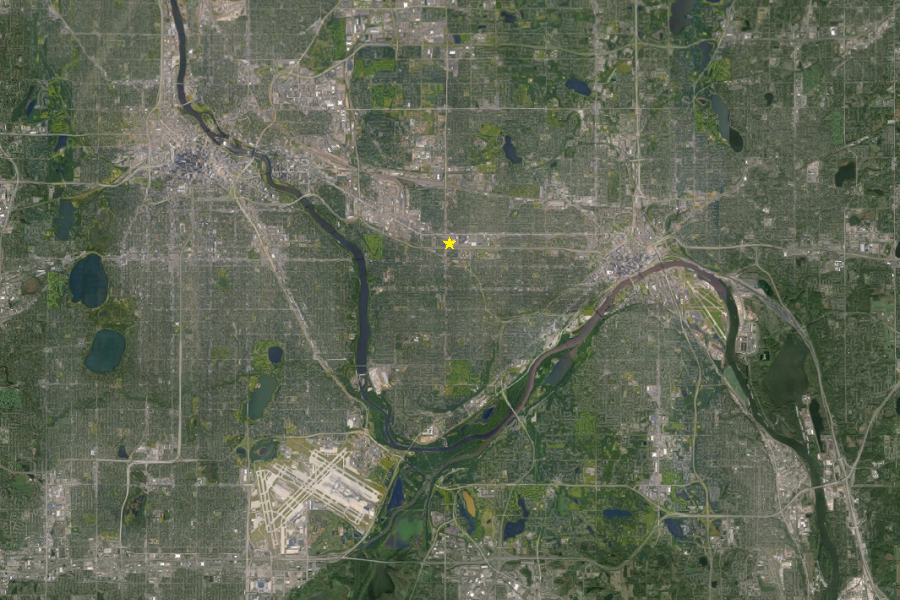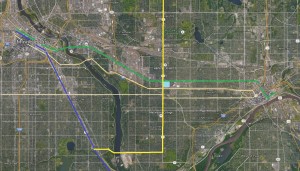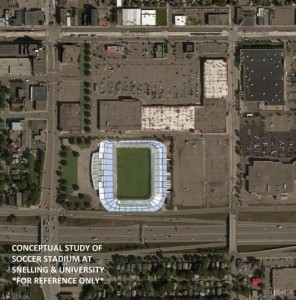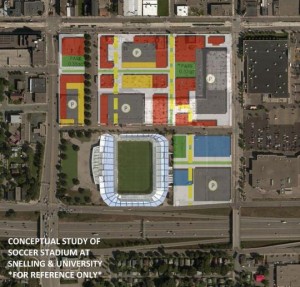After months of incremental movement in the campaign to build a soccer specific stadium in Minneapolis, the entire plot was flipped this past week thanks to the sudden entrance of a familiar character—Saint Paul.
The impetus of this week’s action came from Major League Soccer, who seemed determined to not let Minnesota become another Miami, New York, DC… The league increasingly hardened its their bizarre and unworkable July 1st deadline. Few took the deadline seriously, in part because of how absurd a requirement it was. But the assumption that MLS would simply affirm on the 1st that an acceptable amount of backroom progress had been achieved was not validated. Instead, MLS Deputy Commissioner Mark Abbott appeared on local ESPN radio, and indicated that he would personally fly out to Minnesota, perhaps to meet with Minneapolis, but [i]specifically[/i] to tour alternate sites in Saint Paul.
While a constellation of sites have been floated as potential homes for a soccer stadium in Saint Paul, it has become clear since that the favored location is the old “bus barn” site near the intersection of Snelling and University Avenues. On Thursday, Saint Paul Mayor Chris Coleman officially acknowledged the city’s interest in a soccer stadium, and personally invited Abbott to visit the site and visit the city.
If there was any thought that Saint Paul was being played to gain leverage with Minneapolis, Coleman made his position clear. “I no intention of being a pawn,” he said. Later, he made direct reference to the deputy commissioner’s Minnesota roots. It’s clear that the city, the league, and the team are taking this alternative seriously. In fact, such a compelling case can be made for the bus barn location, that it seems incorrect to even label the site an “alternative”.
When Dr. Bill McGuire first began looking for a permanent home for Minnesota United, well before MLS interest, the bus barn site was one of the first candidates examined. Now, it may well be the final one.
In The Heart Of The City
One of the hallmarks of the MLS 3.0 era has been the insistence upon teams building stadiums within the cities they represent. At one point in league history, places like Frisco, TX, and Bridgeview, IL, made sense as stadium locations. Now, teams that built their homes in suburban or exurban communities are struggling to reach the league’s city-dwelling, often transit-dependent demographic.
Early in their stadium search, Minnesota United FC considered the potential of a stadium near the Mall of America, somewhere among the ocean of parking where the old Metropolitan Stadium once hosted the Kicks. But in winning a spot in MLS, the Loons promised a downtown stadium, and the league has repeatedly referenced this promise as the reason for Minnesota’s selection.
But “downtown” has always been a bit of an ill-fitting requirement. What the league wants above all is that the stadium be reachable by transit and in the midst of the city. That’s why nobody minds that DC United, NYCFC, and David Beckham’s group in Miami are building or looking at sites that are not downtown.
In MSP, that “downtown” designation is perhaps even sillier, because the Twin Cities have a fairly unique urban structure. In law and on paper, Minneapolis and Saint Paul are separate cities, each with their own city government, set of laws, and with surprisingly divergent histories. But in practice, MSP is one city, which just happens to have two downtown cores that are ten miles apart. But unlike, say, Dallas-Arlington-Fort Worth, there is an unbroken fabric of urban development that stitches Minneapolis and Saint Paul together as one entity. If you were to travel from one to the other, you would not be able to identify the city border.
Because of this, there’s actually something of a downside to the proposed Minneapolis stadium. That location would be perfect for residents of Minneapolis, but further away from residents of Saint Paul. Conversely, a downtown Saint Paul stadium (like the Sears site) would be out of the way for residents of Minneapolis. That’s perhaps the chief advantage of the bus barn location. It’s hard to find a more central location in the MSP metro. It would be fitting for a team named Minnesota United FC to put down roots directly in between the state’s two great cities.
Midway
The bus barn location is located in an area of Saint Paul known as “Midway”, near the intersection of two important arterial roads: University and Snelling Avenues. Snelling runs from the first ring suburb of Roseville, along the state fairgrounds, through the western neighborhoods of Saint Paul and to the Mississippi river. University is a road that essentially connects downtown Minneapolis to downtown Saint Paul, and passes through the University of Minnesota on the way.
Despite its central location in the Twin Cities, Midway was a peripheral area to both Minneapolis and Saint Paul as the cities expanded towards each other. As a result, the district is populated by peripheral land uses. The bus barn site is so named because it used to be a building where streetcars and later buses were stored. That building was torn down in 2002 and the site has been used as storage for road refuse ever since. Adjoining the site is a lot of strip mall and big box style development, including a liquor store, a bowling alley and deli, and a supermarket owned by a company which also owns the supermarket a block east. A Walmart and a Super Target are also in the vicinity. The surrounding neighborhoods are mixed in income. In general, the area to the south of Midway, across I94, is a bit wealthier than the area to the north. Midway is also surrounded by a number of private colleges, including Hamline University just to the north, Concordia University to the east, and Macalester College to the south. As a result, student and teacher housing peppers the surrounding area.
Because of the poor use of the land and its position at the heart of so much disposable income, Saint Paul has been trying to redevelop Midway for over a decade, with little success. But [url=http://www.twincities.com/localnews/ci_26142857/snelling-university-urban-village-plans-take-shape-but]momentum has picked up recently[/url], thanks to some major infrastructure improvements that will make Midway one of the most connected points in the entire metro.
Illustrated: The Green Line LRT, Blue Line LRT, A-Line aBRT (yellow), and 21 and 94 bus routes (tan).
The most important change has been the debut of the Green Line Light Rail, which runs from downtown to downtown along University. The light rail has smashed ridership projections and has spurred a wave of transit oriented development in just a year of operation. The line has a stop at Snelling Avenue that is just a block away from the bus barn site. Every single professional and college sports facility in the Twin Cities is located along the Green Line, and Minnesota sports fans are well accustomed to taking the train to games. This past fall and winter, up to 25% of Vikings fans took the light rail to games at the University’s TCF Bank Stadium.
Next spring, Snelling Avenue will be getting its own mass transit treatment in the form of the Twin Cities’ first Arterial Bus Rapid Transit (aBRT) line. Named the A-Line, the bus will run from Roseville to the Blue Line LRT at the 46th street station. The A-Line service should provide a north-south transit axis to match the Green Line’s east-west service. The bus barn site is located just steps from where these two lines will cross.
Additionally, just a few blocks south is the 21 bus, which runs from downtown Saint Paul to the booming Uptown neighborhood of Minneapolis, passing through neighborhoods of just about every ethnicity and income level in the process. It has the second highest ridership of any bus route in the Twin Cities.
To cap it all off and add to the transit service, the bus barn site directly borders I-94, which runs in between downtown Minneapolis and Saint Paul. Like most midwestern cities, the tendrils of the highway connect just about every part of the metro area.
Illustrated: The Green Line LRT, A-Line aBRT (yellow), and 21 bus route (tan).
New Vision
Despite the clear potential of the Midway area, development has been slow, in large part because of what is already there. The Snelling-94-University intersection is one of the busiest in the state (although it’s unclear just where it ranks) and the constant congestion can be a downside. The constant roar of the highway also hurts the values of the land adjacent. And the huge lot sizes that prop up the big box/strip mall development are hard to sell and develop.
When Minnesota United FC first looked at the bus barn as a potential stadium site, it is believed that the city and the Metropolitan Council (the owner of the land) were not tremendously receptive to the idea because they hoped to put the land on the market and develop it. But good plans for the area have not come as quickly as was hoped, and a study argued that the gap between what would need to be done at the site and what developers would pay was substantial. With little redevelopment progress two years later, the city and the transit agency have come to see a stadium as a possible answer to some of the site’s problems. An excellent case for this view was made Chris Iverson on the local urban policy website Streets.mn.
As this website has covered in the past, stadiums tend to be poor development drivers. That said, this writer has also written optimistically that some issues that stadium’s bring can be overcome with better design.
One of a soccer stadium’s unquestioned benefits would be to ameliorate part of the land from the adverse effects of the highway. Land next to a nice piece of architecture would surely be more appealing for developers than land next to a vacant lot or a sunken highway. The thinking goes that eliminating the highway from the picture could catalyze development of the parcel at the University and Snelling intersection, which is currently occupied by the liquor store, a vacant retail space, and a vacant bank.
Plenty would hinge upon the design of the stadium. Friend of the site Adam Jarvi is an architect with some experience in stadium design. He put together a conceptual image of what the stadium and the Midway area could look like, and listed some great thoughts about the potential for the site.
First the stadium (the stand-in being used here is Sporting Park) as it would likely be oriented within the bus barn lot:
Next, the stadium with future TOD imagined in place the Midway shopping center:
Here’s what Adam wrote about these mock-ups:
• The 9.78acre bus barn site is ideally sized for a soccer stadium in the 18-22k range.
• The ideal north/south orientation works and there is space for stands on all four sides. This is especially important on a site with no external focal point (as is also the case with Sporting Park in suburban Kansas City). A dramatic backdrop such as a skyline view, can help “define” the space in a 3-sided venue, but without it you risk losing the intimate sense of enclosure that prevents the atmosphere from “bleeding” out, one of the biggest architectural problems with the current Loons’ stadium at NSC. In stadium design, it’s important to knit the crowd together so it can act as one. NSC, for example, is very much just a collection of individual stands.
• Depending on setback requirements on the north and south ends, which I haven’t studied in detail for this site, the layout could end up very much like Sporting Park with 3 stands of equal height and one shorter stand at the north or south end. That difference could also be made up more symmetrically, with two larger stands along the sidelines and two slightly shorter ends. A steeper rake on the stands would also help “shrink” the stadium in plan, but there’s a limit both in terms of comfort and code-driven safety associated with that.
• With plenty of space in the east/west direction, the stadium could play a key role in (re)shaping the urban fabric of the site.
• Since it will likely be the first piece of a larger redevelopment of the area, working closely with city planners will be critically important for the site’s future success.
• Planning documents for the site, including the Snelling Station TOD study, all indicate a hard edge along Snelling. While the stadium could certainly be aligned this way, pushing it back from the street could create a plaza or green space that could double as a buffer from the adjacent residential neighborhood to the west of Snelling and give fans a distinct place to gather.
• Either way, creating a defined inviting pedestrian and bike connection from the LRT station and University on the north and the bustling Selby/Snelling area across 94 to the south should be a priority.
• Recent studies have called into question the ability of stadiums to deliver on promised development of surrounding areas. I’d argue, though, that both the Royalston and the Snelling sites are unique in that the momentum for redevelopment has already started. In both cases, a stadium wouldn’t be the sole reason for surrounding development, but would help jump start it with much needed infrastructural upgrades that may otherwise not be justifiable on the basis of mixed use commercial alone. In fact, the excitement of TOD at the Snelling site was dampened by the Met Council’s study that found a large gap between the cost of necessary infrastructure upgrades (parking was a big one) and the projected market value of new retail/residential development. Investment associated with a stadium—shared parking structures, for example—could help bridge this gap.
Adam’s comments make it clear why the city of Saint Paul would now be newly interested in the prospect of a stadium on the site. A soccer stadium could provide the spark that sets in motion a number of upgrades to the area, including new streets that cut down the lot size, walking and pedestrian accommodations across the highway, and beyond. While those details are obviously a long way away from being worked out, they could play a crucial role in greasing the skids for a soccer stadium deal.
Remaining Challenges
There is still a lot to sort out. Parking and traffic are the two biggest pieces, but neither are insurmountable. The city owns a lot near to the stadium, and further parking accommodation could potentially be found behind the stadium, where there is another, closely associated lot. Redesigning the nearby streets for gameday traffic would also be a challenge, but with MLS games occurring at off-peak hours, true gridlock should be simpler to avoid than some might assume.
The final challenge would to overcome the problems that have sabotaged the Minneapolis effort. Saint Paul and the team must come to terms on the taxing for the site. But the headwinds in Saint Paul are less. For one, the site is already untaxed, meaning the city would come out ahead if it received any tax money at all from a stadium. Second, Saint Paul appears to offer more political support. Third, Saint Paul has long suffered from an inferiority complex compared to its more modern, flashier neighbor. The city became a draw for sports fans by building the Xcel Energy Center for the Minnesota Wild hockey team around the turn of the century. The new Saint Paul Saints stadium in Lowertown has been hailed as an urban gem. But the city would absolutely love to be able to also boast major league soccer, which it sees as a dynamic antidote to its sleepy, stuffy, Catholic (Minneapolis was the Protestant town) image.
Once again, all we know at this point is that both sides are interested. But the pieces are in place for a deal. The site would be fantastic for Minnesota United FC, both in terms of size and connectivity. Arguably, it trumps the Minneapolis site on both those counts, only lacking the sex appeal of a skyline view. On the other side, the city of Saint Paul has a strong interest in finding a use for the bus barn site, and developing a larger plan that develops the Midway area. With the intervention of MLS in the coming weeks, the plan could come together quickly.
“I believe that in the next few weeks, we could have a clear path forward for a stadium on that site”, said Mayor Coleman. That would be record time. But it might be enough for MLS to see such rapid progress. With a great piece of land and political support, Saint Paul might well be the soccer home for Minnesota that unites everyone in support.





Leave a Reply